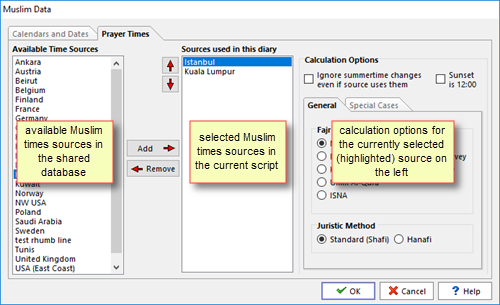The Prayer Times tab of the Muslim Data Source property editor is used to select the Muslim Times Data Source(s) used to evaluate Muslim Times Tokens.

For each source, the panel on the right contains all the options necessary to the calculation of Muslim Prayer Times according to any of the generally accepted methods of calculation.
Each selected source has its own set of calculation options.
Ignore Summer Times, even if source uses them (not recommended) |
If you select this option, then all prayer times will be calculated and displayed as if the location used to calculate them did not follow summer time rules. This is not recommended as it will provide times that are an hour off from readers' experiences for half of the year. The only reason to use this option is to match customer data which may have neglected summer time effects by error. |
12:00 is Sunset |
This method is particular to Saudi Arabia and calculates times using the day's sunset as 12:00. Usually only used in the context of the Um Ul-Qura calculation method which means that Maghrib always occurs at 12:00 and Isha at 1:30 (or 2:00 during Ramadan). |
Fajr and Isha Convention |
This option lets you select between the 5 main methods of calculating Fajr and Isha (the dawn and dusk prayers). The method used depends generally on geographical location. When in doubt, you should contact your client. |
Juristic Method |
The Juristic Method determines how the time of the afternoon prayer (Asr) is calculated. Most schools follow the Shafi method, but if in doubt you should ask your client. |
Safety Times |
It is customary to add safety times to ensure that prayers are not offered too early. How many minutes to add to which prayer is dependent on personal preferences, and our recommendation is to display the exact times resulting from astronomical calculations (ie. use 0 for all safety times) and let the user add his own preferred safety times. In the event that you do use non-zero safety times, it is very important to clearly mark the safety times that you are using in a footnote. |
High Latitudes |
Because of the relatively high depression angles used in the various methods of calculating Fajr and Isha, geographical locations above 48 degrees of latitude will have some days for which dawn and dusk are not defined. To get around this problem, various methods are used to determine a time for the dawn and dusk prayers. If the location used to calculate Muslim prayer times is above 48 degrees of latitude (roughly the US-Canada border or Paris in France) you should pay particular attention to this option. |
Note that you can select the same Muslim Data Source twice, since you may want to display it once using one juristic calculation method, and once using another method. This is also useful in Saudi Arabia where it is common to display prayer times using both the standard 12:00 is midnight, and the 12:00 is sunset method discussed above.
Topic 175705, last updated on 26-Aug-2020